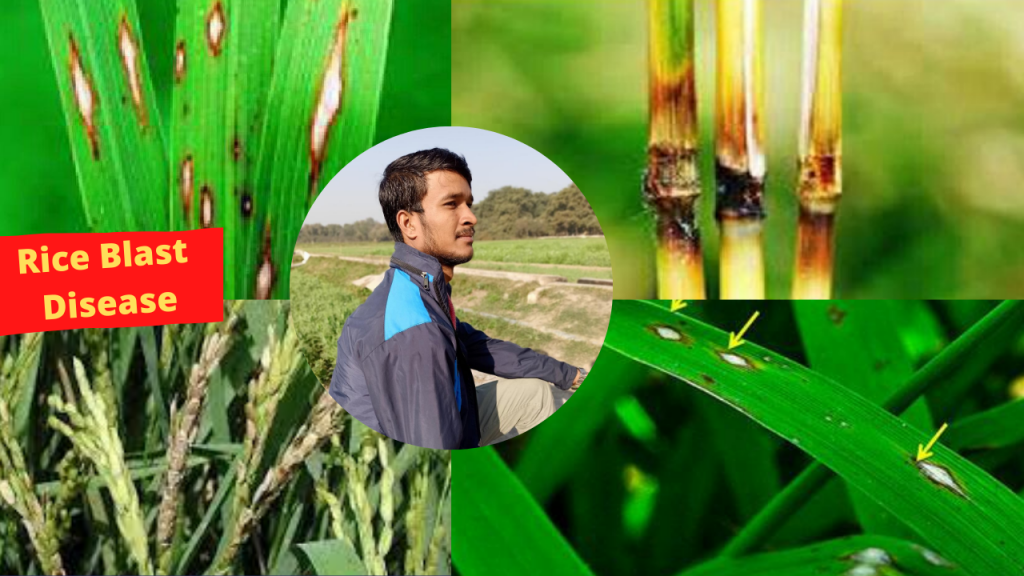Rice Blast Disease: Economic Importance & Management Practices

Blast disease was first recorded in China in 1637.In Japan, it is believed to have occurred as early as in 1704. In Italy this disease was recorded in 1828 for name of brusone and in USA it was recorded in 1876. The disease was first recorded in India from Tanjore district of Tamil Nadu in 1978.
Rice blast is also known as Magnaporthe grisea.The fungus is known to occur in 85 countries worldwide. Rice blast cause economically significant crop losses annually.
Economic Importance
Rice blast is the most important disease concerning the rice crop in the world. Since rice is an important food source for much of the world, it’s effects have a broad range. Every year the amount of crops lost to rice blast could feed 60 million people worldwide. the pathogen cause yield loss ranging from 30-61 % depending upon the stage of infection. In severe cases, losses amounting to 70-80 % of grain yield are reported.
Symptoms
This disease fungus attacks the crop at all stages from seedlings in nursery to heading in main field. The typical symptoms appear on leaves, leaf sheath, rachis, nodes and even the glumes are also attacked. 
Leaf Blast : On the leaves, the lesions start as small water soaked bluish green specks, soon enlarge and from characteristics spindle shaped spots with grey center and dark brown margin. The spots join together as the disease progresses and large areas of the leaves dry up and wither. Similar spots are also formed on the sheath. Severely infected nursery and field show a burnt appearance.

Node Blast: In this case nodes are infected,irregular black areas that encircle the nodes can be noticed. The affected nodes may break up and all the plant parts above the infected nodes may die.

Neck Blast: At the flower emergence, the fungus attacks the peduncle which is en-girdled, and the lesion turns to brownish-black. In early neck infection, grain filling does not occur and the panicl remains erect like a dead heart caused by a stem borer. In the late infection, partial grain filling occur. In case of heavily infected panicles small brown to black spots also may observed on glumes.

Favorable Conditions : Application of excessive does of nitrogenous fertilizers, cloudy weather, high relative humidity (93-99)%,intermittent drizzles, more number of rainy day, low night temperature (between 15-20°c or less than 26°c),longer duration of dew, cloudy weather, slow wind movement and availability of collateral hosts.
Forecasting :Forecasting blast of rice can be made on the basis of minimum night temperature range of 20-26 °c in association with a high relative humidity range of 90 % and above lasting for a period of a week or more during any of the three susceptible phase of crop growth, viz, seedlings stage, post transplanting tillering stage and neck emergence stage.the first leaf model was developed and named as Blast in Japan.
Management
•Grow resistant varieties like Resistant to leaf and neck blast disease : chhomrong,machhapuchhre-3,lekali dhan-
3,lumle -2, Chandannath-1&3
• Resistant to blast disease : Khumal -4
• Use of seeds from a disease free crop.
• Destroy the weed hosts in the field bunds and channels.
• Split application of nitrogen and judicious application of nitrogenous fertilizers
• Keep water in the field.
• Treat the seeds with captan or thiram or carbendazim or carboxin or tricyclazole at the rate of 2g/kg of seeds.
• Spray the nursery with biocontrol agent Trichoderma viride @4g/kg and avoid close spacing of seedlings in the
field.
• Spray the nursery with carbendazim 25g or Edifenphos 25 ml .
• Spray the main field with Edifenphos @0.1% or carbendazim @0.1% or Thiophanate methyl @0.1% or Tricyclazole 75%
we 0.75g/lit. Water or sugamysen 3% SL. 9.5 ml/lit. Water .
Article By: Sirpat Badhai, Bsc (hons)Ag from institute of agricultural sciences Banaras Hindu university u.p.221005, India

